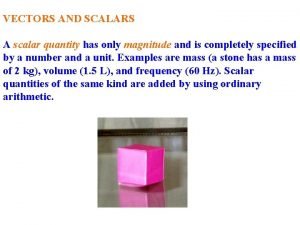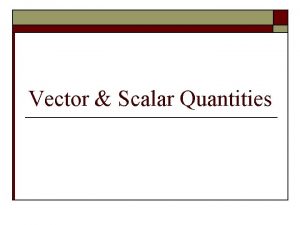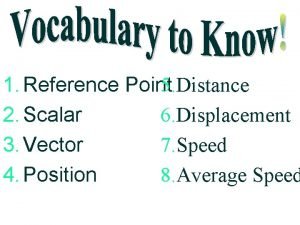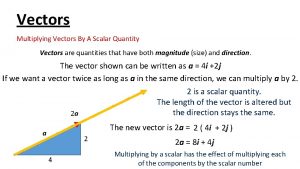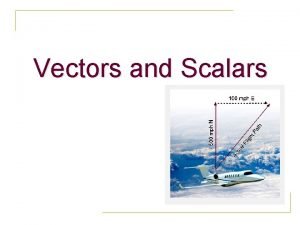Vectors SCALAR any quantity in physics that has








- Slides: 8

Vectors

SCALAR - any quantity in physics that has MAGNITUDE ONLY (measurable quantity) Number value with units VECTOR quantity - any quantity in physics that has BOTH MAGNITUDE and DIRECTION An arrow above the symbol illustrates a vector quantity. Scalar Example Magnitude Speed 35 m/s Distance 25 meters Age 16 years Vector Example Magnitude and Direction Velocity 35 m/s, North Acceleration 10 m/s 2, South Force 20 N, East

Vector Components

Vector Application ADDITION: When two (2) vectors point in the SAME direction, add them together. EXAMPLE: A man walks 46. 5 m east, then another 20 m east. Calculate his displacement relative to where he started. 46. 5 m, E + 20 m, E 66. 5 m, E MAGNITUDE relates to size of arrow DIRECTION relates to the way the arrow is drawn

Vector Application SUBTRACTION: When two (2) vectors point in the OPPOSITE direction, subtract them. EXAMPLE: A man walks 46. 5 m east, then another 20 m west. Calculate his displacement relative to where he started. 46. 5 m, E - 26. 5 m, E 20 m, W

Perpendicular Vectors When two (2) vectors are PERPENDICULAR to each other, use PYTHAGOREAN THEOREM Example: A man travels 120 km east then 160 km north. Calculate his resultant displacement. the hypotenuse is called the RESULTANT FINISH 160 km, N VERTICAL COMPONENT c = resultant = c = 200 km S T A R T 120 km, E HORIZONTAL COMPONENT

What about direction? In the example, DISPLACEMENT is asked for. It is a VECTOR quantity---we need direction. N W of N E of N N of E N of W E W N of E NOTE: When drawing a right triangle that conveys some type of motion, you MUST draw your components HEAD TO TOE. S of E S of W E of S W of S S

46. 5 m, E + 20 m, E 46. 5 m, E - 20 m, W 26. 5 m, E 66. 5 m, E the hypotenuse is called the RESULTANT S T T A R FINISH 160 km, N VERTICAL COMPONENT 120 km, E HORIZONTAL COMPONENT




